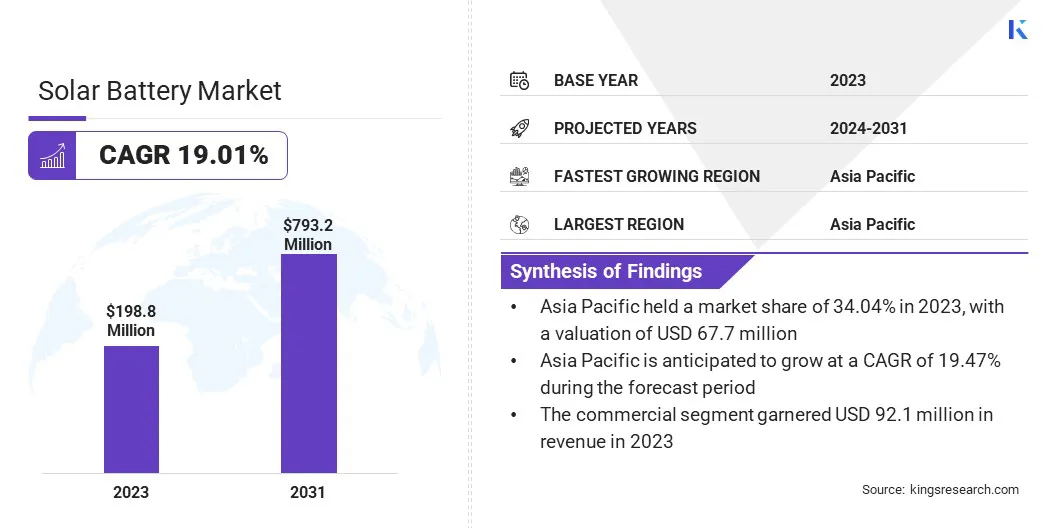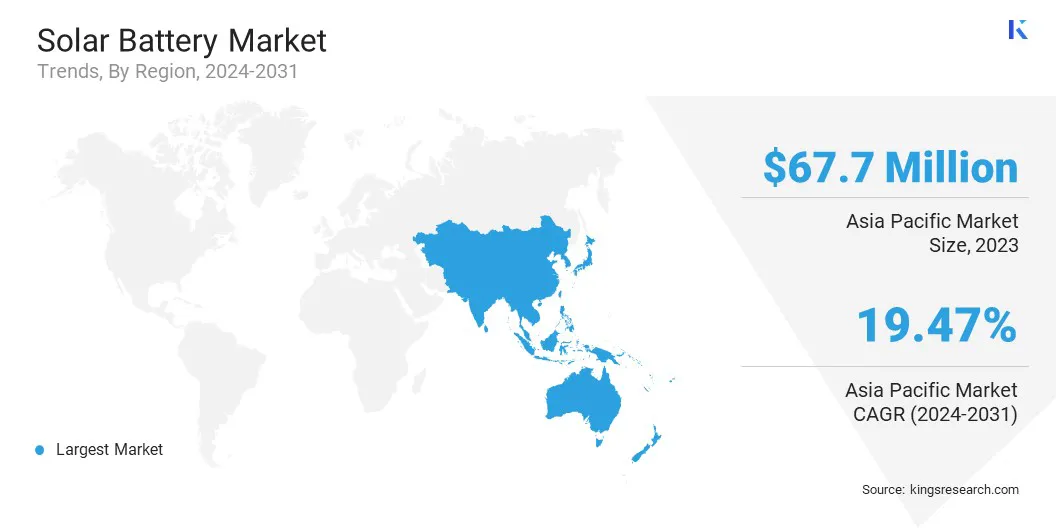Market Definition
The market involves the development, production, and distribution of energy storage systems that store electricity generated from solar power. These batteries enable the efficient use of solar energy by storing excess power for later use, particularly in off-grid or hybrid systems.
The market includes various battery technologies, such as lithium-ion, lead-acid, and flow batteries, catering to both residential and commercial sectors.
Solar Battery Market Overview
The global solar battery market size was valued at USD 198.8 million in 2023 and is projected to grow from USD 234.6 million in 2024 to USD 793.2 million by 2031, exhibiting a CAGR of 19.01% during the forecast period.
This growth is primarily driven by the increasing adoption of renewable energy sources, particularly solar power, along with significant advancements in energy storage technologies. Solar batteries are critical in enhancing the stability and reliability of solar power systems by enabling the storage of excess energy for use during periods of low or no solar generation.
Major companies operating in the solar battery market are BYD Company Ltd., LG Energy Solution, Panasonic Corporation, SAMSUNG SDI., Exide Industries Ltd, Amara Raja Energy & Mobility Limited., Luminous India, OKAYA POWER PVT. LTD., Tesla, sonnen, Enphase Energy., Huawei Technologies Co., Ltd., Bluetti Power, Generac Power Systems, Inc., and SolarEdge.
Market growth is further supported by the declining costs of solar battery technologies, improvements in performance, and growing consumer awareness regarding energy independence. Moreover, the integration of solar batteries with smart grids and home energy management systems is anticipated to aid this growth.
- In February 2024, the Solar Energy Corporation of India Limited (SECI), under the Ministry of New and Renewable Energy, commissioned India's largest Battery Energy Storage System (BESS). The 40 megawatt (MW) /120MWh BESS is integrated with a solar photovoltaic (PV) plant that boasts an installed capacity of 152.325 megawatt hour (MWh) and a dispatchable capacity of 100MW AC (155.02 MW peak DC).

Key Highlights:
- The solar battery industry size was recorded at USD 198.8 million in 2023.
- The market is projected to grow at a CAGR of 19.01% from 2024 to 2031.
- Asia-Pacific held a share of 34.04% in 2023, valued at USD 67.7 million.
- The lithium ion segment garnered USD 63.4 million in revenue in 2023.
- The commercial segment is expected to reach USD 359.4 million by 2031.
- Asia Pacific is anticipated to grow at a CAGR of 19.47% over the forecast period.
Market Driver
"Technological Advancements in Energy Storage"
Notable improvements in lithium-ion batteries, characterized by higher energy density, longer lifespan, and faster charging times, have positioned them as the dominant technology. Advancements in battery management systems (BMS) have further enhanced safety, reliability, and performance, fueling the growth of the solar battery market.
Emerging technologies such as solid-state, flow, and sodium-ion batteries offer potential for greater energy efficiency, safety, and sustainability. Furthermore, innovations in materials science, including graphene, are contributing to enhanced battery performance.
These technological developments are reducing costs, increasing efficiency, and expanding the viability of solar storage solutions across residential, commercial, and industrial applications, accelerating market expansion.
- In June 2023, Panasonic Corporation announced a new generation of the EVERVOLT Home Battery System, a modular residential storage solution supporting both DC and AC coupling, making it a versatile solution for both new and existing solar installations. It integrates a hybrid inverter, lithium-ion battery and new EVERVOLT SmartBox, an all-in-one home energy management device.
Market Challenge
"Battery Lifespan and Degradation"
Battery lifespan and degradation remain key challenges in the solar battery market. Lithium-ion batteries, in particular, lose capacity over time due to charge-discharge cycles, typically, degrading by 20-30% within 10-15 years.
This reduces energy storage capacity and may necessitate premature replacements, increasing long-term costs. Factors such as depth of discharge furher accelerate degradation, with deeper discharges leading to faster wear.
Improvements in battery management systems (BMS) can optimize charge cycles and reduce degradation. The development of more durable solid-state and flow batteries offers longer lifespans with slower degradation. Adopting shallow discharge cycles can help extend battery life by avoiding deep discharges.
Investment in recycling technologies for end-of-life batteries can also mitigate environmental impacts and reduce reliance on raw materials. These strategies collectively enhance battery longevity, reduce long-term costs, and promote sustainable energy storage.
Market Trend
"Growing Integration of Solar Batteries with Smart Home and Energy Management Systems"
The growing integration of solar batteries with smart home systems is emerging as a notable in the solar battery market. As consumers place greater emphasis on energy independence and efficiency, these systems enable real-time monitoring and control of energy consumption.
This integration facilitates automated energy storage, usage optimization, and the export of excess energy back to the grid, enhancing efficiency and reducing costs. Moreover, with the increasing adoption of smart thermostats, EVs, and home automation, solar battery systems are being designed to interface seamlessly with other connected devices, strenghtheing energy management and sustainability.
This trend is particularly prevalent among residential users seeking greater control over their energy systems, positioning solar batteries as a key component of smart, sustainable homes.
- In February 2025, SolarCraft announced the addition of Franklin Whole Home Batteries to its energy-efficient home solutions. This collaboration enhances its ability to offer advanced, reliable, and scalable battery storage for residential and commercial solar energy systems, supporting energy independence and efficiency.
Solar Battery Market Report Snapshot
|
Segmentation
|
Details
|
|
By Type
|
Lead Acid, Lithium Ion, Flow Battery, Others
|
|
By End-User
|
Residential, Industrial, Commercial
|
|
By Region
|
North America: U.S., Canada, Mexico
|
|
Europe: France, UK, Spain, Germany, Italy, Russia, Rest of Europe
|
|
Asia-Pacific: China, Japan, India, Australia, ASEAN, South Korea, Rest of Asia-Pacific
|
|
Middle East & Africa: Turkey, UAE, Saudi Arabia, South Africa, Rest of Middle East & Africa
|
|
South America: Brazil, Argentina, Rest of South America
|
Market Segmentation
- By Type (Lead Acid, Lithium Ion, Flow Battery, and Others): The lithium ion segment earned USD 63.4 million in 2023, driven by its higher energy density, longer lifespan, and growing adoption in both residential and commercial applications.
- By End-User (Residential, Industrial, and Commercial): The commercial segment held a share of 46.33% in 2023, fueled by the increasing demand for reliable and cost-effective energy storage solutions for businesses and large-scale operations.
Solar Battery Market Regional Analysis
Based on region, the global market has been classified into North America, Europe, Asia Pacific, Middle East & Africa, and Latin America.

Asia Pacific solar battery market accounted for a substantial share of around 34.04% in 2023, valued at USD 67.7 million. This dominance is attributed to rapid urbanization, increased government support for renewable energy adoption, and a growing shift toward sustainable energy solutions across key markets such as China, India, and Japan.
The region's favorable policies, including incentives and subsidies for solar energy installations, further propel the demand for solar battery systems. The regional market benefits from the expansion of solar power generation across residential and commercial sectors, highlighting the need for efficient storage solutions.
- In February 2025, Tata Power Renewable Energy Limited signed a non-binding Memorandum of Understanding (MoU) with Oil and Natural Gas Corporation Limited (ONGC) to explore joint opportunities in the Battery Energy Storage System (BESS) and its value chain.
Europe solar battery industry is estimated to grow at a robust CAGR of 19.04% over the forecast period, charaterized by strong policy support and a concerted shift toward decarbonization. The European Union's commitment to achieving net-zero emissions by 2050 and various national mandates for renewable energy adoption are stimulating the demand for solar batteries.
The growing integration of solar power with energy storage systems, particularly in countries such as Germany, France, and the United Kingdom, is enhancing grid stability and energy independence. Consumer awareness of sustainability, coupled with declining costs of solar battery technologies, is further propelling adoption in both residential and commercial sectors.
Regulatory Frameworks:
- The Federal Energy Regulatory Commission (FERC)'s Order No. 841 (2018) removes barriers for energy storage systems in wholesale electricity markets, enabling storage systems to provide services such as frequency regulation and energy arbitrage. This enhances grid reliability and supports the integration of renewable energy.
- The European Green Deal, introduced by the European Commission , aims for net-zero carbon emissions by 2050, fostering the transition to a sustainable, low-carbon economy. This regulation promotes the adoption of renewable energy technologies, including solar power and energy storage solutions, through financial incentives and supportive policies.
- The International Electrotechnical Commission (IEC) established IEC 62933-1:2024, setting standards for energy storage systems, including design, performance, environmental, and safety requirements.
- The National Fire Protection Association (NFPA) developed safety guidelines under the National Electrical Code (NEC), specifically Article 706, which governs the installation of energy storage systems, including solar batteries.
Competitive Landscape
Participants in the solar battery industry are focusing on strategic initiatives such as product innovation, mergers and acquisitions, and partnerships to enhance their market positions. Leading companies are investing heavily in research and development to improve battery efficiency, lifespan, and cost-effectiveness while exploring advanced technologies such as solid-state and flow batteries.
The competitive environment is further intensified by the increasing emphasis on sustainability and energy independence, compelling companies to differentiate through value-added services and superior customer support.
- In January 2025, the President of the UAE inaugurated the world’s first 24/7 Solar PV Battery Storage Gigascale project in Abu Dhabi. This initiative aims to provide continuous solar energy by integrating large-scale solar photovoltaic (PV) technology with advanced battery storage solutions.
List of Key Companies in Solar Battery Market:
- BYD Company Ltd.
- LG Energy Solution
- Panasonic Corporation
- SAMSUNG SDI.
- Exide Industries Ltd
- Amara Raja Energy & Mobility Limited.
- Luminous India
- OKAYA POWER PVT. LTD.
- Tesla
- sonnen
- Enphase Energy.
- Huawei Technologies Co., Ltd.
- Bluetti Power
- Generac Power Systems, Inc.
- SolarEdge
Recent Developments (M&A/Partnerships/Agreements/New Product Launch)
- In September 2024, SolarEdge Technologies, Inc. unveiled its next-generation single-phase solar + storage solution at RE+. The new residential sytem integrates a scalable battery with a solar inverter of up to 11.5kW, providing highly flexible whole-home backup solutions across the United States.
- In July 2024, Tesla and Intersect Power signed a contract for 15.3 GWh of Megapacks, Tesla’s battery energy storage system, for Intersect Power’s solar + storage project portfolio through 2030. This agreement, along with prior commitments, positions Intersect Power as one of the largest global buyers and operators of Megapacks, with nearly 10 GWh of large-scale energy storage expected by 2027.
- In May 2024, The World Bank Group, Abu Dhabi Future Energy Company PJSC (Masdar), and the Government of Uzbekistan signed a financial agreement to develop a 250-megawatt (MW) solar photovoltaic plant with a 63-MW battery energy storage system (BESS).


